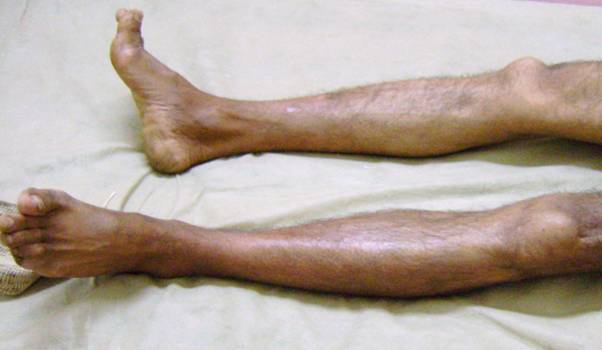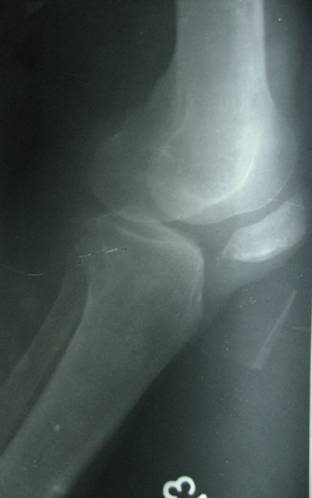Sheikh Irfan Bashir*,Abdul Manan**,Danish Ashraf Wani***,Owais Ahmed Tantray****,Rouf Ahmed Bhat*****
*Department Of Orthopaedics,
**Department Of Anaesthesia,
***Department of surgery,
****Department Of Radio Diagnosis
*****Department Of Surgery,
Address for Correspondence
Sheikh Irfan Bashir (M.B.B.S)
S/O:- Sheikh Bashir Ahmed
R/O:- Shah-E- Hamdan Lane, Umerabad, Zainakote, Srinagar, Kashmir, J&K, India.
Phone no. 011-7838834525.
Email-sheikhirfanb@gmail.com
|
Abstract:
Intra-articular dislocation of the patella is a very rare injury. Two types of intra-articular dislocation have been described. A horizontal type where the patella has rotated on its horizontal axis with the articular surfaces either facing proximally or distally. In the second type, the patella rotates on its vertical axis and the articular surface either faces medially or laterally. The former one is the most rare variety of intrarticular dislocation of patella. We could not find any case of bilateral intra-articular dislocation of patella reported in English literature. We report a case of 60 year old male presenting to the O.P.D. with 5 yr history of pain and decreased range of movements of bilateral knees. X-ray of the knees revealed bilateral intra-articular dislocation of patella with patella facing proximally. The patient was electively taken up for open reduction and reinforcement of the patellar tendon was done. The patient performed well on early follow-up.
J.Orthopaedics 2011;8(1)e2
Keywords:
Intra-articular dislocation of the patella, rotation of the patella, Neglected dislocation patella, Bilateral dislocation patella, atraumatic, elderly.J.Orthopaedics 2011
Case report:
A 60 year old Indian male belonging to lower socio-economic strata presenting to the O.P.D. with chief complaints of pain and decreased range of motion bilateral knees since 5 years .pain was insidious in onset, moderate to severe in intensity earlier. As the time passed by the intensity of pain first increased only to decrease as the time passed by . The patient was bed ridden for few months after which he stated to walk with the help of stick. The patient also developed decreased range of motion since five years. There is no history of any pain in the knee joints or any other joints prior to this. No other significant past history. On examination there is abnormal bulge at knee (Figure1). On flexion of knee the femoral condyles are evident along with the protuberant patella (Figure2). The knee range of motion is 10 degree to 90 degrees. On radiograph (lateral view) the patella is dislocated within the joint with the articular surface facing proximally or femoral condyles. The radiograph confirmed the bilateral horizontal intra-articular dislocation with articular surface facing proximally (Figure 3 and 4). There were mild osteoarthritic changes visible on the radiograph.
We did not attempt any closed reduction as the dislocation was neglected and many years old. we informed the patient about the condition and management. We arranged an elective surgery for open reduction. Through midline approach the joint was opened and the patella was put into the position and the reinforcement of the patellar tendon done by the modified bunnel sutures. The joint was cleared of small adhesions and thoroughly irrigated. The joint was mobilised under the effect of spinal anaesthesia and range of motion checked properly. The incision was closed in a routine manner and the legs placed in a knee immobilizer post-operatively. The repair has remained intact in early follow-up. Patient is now under regular follow-up since one year.
Discussion.
Intra-articular dislocation of the patella is a very rare injury. Since Midelfart reported the first case in 1887, 48more cases have been published globally. We could not find any report of bilateral intra-articular dislocation of patella. Almost all of the reported cases have been found in adolescents and that also due to sudden trauma. In our case the elderly patient developed the intra-articular dislocation only over a period of time as there is no acute episode of trauma. Two types of intra-articular dislocation have been described. A horizontal type where the patella has rotated on its horizontal axis with the articular surfaces either facing proximally or distally (1, 2, 3, 4). In the second type, the patella rotates on its vertical axis and the articular surface either faces medially or laterally (5,6,7).
Sheikh’s Classification of dislocation of patella.
Patellar dislocation |
Intra-articular dislocation(I) |
Extra-articular dislocation.(E) |
A. Over horizontal axis |
B. Over vertical axis |
A. Medial dislocation |
B. lateral dislocation |
1. Articular surface
facing Proximally.(p) |
1. Articular surface Facing medially(m) |
|
2. Articualr surface
facing distally(d) |
2. Articular surface
facing laterally(l) |
|
These injuries have been described mostly in adolescent boys or young males sustaining blunt trauma in a fall or during sports. A few Occurrences in older age groups and dislocations without any clear mechanism of injury have been reported (8, 9). Garner et al. reported one case on intra-articular dislocation seen in an elderly arthritic knee (10).
The injury mechanism is complex: during knee flexion, the patella is located below the femoral condyles (figure4). It is suggested that when force is applied to the upper pole of the patella, it is being pushed backwards and rotated transversely. The force is then applied to the quadriceps’ tendon, the posterior fibers of which are detached. The patella’s upper pole and anterior surface are located in the intercondylar notch of the femur. The detachment of the posterior fibers of the tendon, because of its passive distension as well as its strong reflex contraction, causes the patella to lock and usually causes complete detachment of the tendon.
Quadriceps tendon avulsion is the more common finding, but patella tendon tears have also been reported (11, 4).
Closed reduction with sedation is never successful and general anaesthesia is required. There have been reports of successful closed reduction under general anaesthesia, but the majority of these injuries require open reduction (3, 8, 12). Brady and Russell, in their report and review of cases have recommended open reduction for such cases as the primary procedure (1).
Post-operative immobilisation is in a cylinder cast or soft bandage for 4—6 weeks with weight bearing allowed as tolerated. Subsequent mobilisation and strengthening exercises is started after cast removal. In the previous case reports, subsequent follow-up of these injuries showed full recovery.
In our case the patient developed bilateral intra-articular dislocation insidiously and there is no history of any acute traumatic episode and the patient is an elderly of age 60 years . There are no severe osteoarthritic changes on radiograph of the knees. We did open reduction of the dislocation and the post-operative period was uneventful. Patient progressed with good recovery post-operatively.

Figure 1. showing abnormal bulge over bilateral knees.

Figure 2. showing protuberant patellae and prominent femoral condyles .

Figure 3: showing left knee with intra-articular dislocation patella with patella facing femoral condyles,

Figure 4. showing right knee with intra-articular dislocation of patella and patella facing to femoral condyles.
References.
1. Brady TA, Russell DJ. Intra-articular horizontal dislocation of patella. J Bone Joint Surg. 1965; 47-A:1393.
2. Feneley RC. Intra-articular dislocation of the patella. Report of a case. J Bone Joint Surg Br 1968; 50(3):653—5.
3. Frangakis EK. Intra-articular dislocation of the patella: a case report. J Bone Joint Surg 1974; 56-A:423.
4. Shaw DL, Giannoudis PV, Archer IA. Intra-articular dislocation of patella. Injury 1995; 26(4):273—4.
5. Alioto RJ, Kates S. Intra-articular vertical dislocation of the patella: a case report of an irreducible patella dislocation and unique surgical technique. J Trauma 1994; 36(2):282—4.
6. Colville J. An unusual case of patella dislocation. Injury 1978; 9(4):321—2.
7. Corso SJ, Thal R, Forman D. Locked patella dislocation with vertical axis rotation. Clin Orthop 1992; 279: 190—3.
8. Garrison RT, McCabe JB. An unusual case of intra-articular dislocation of the patella. Ann Emerg Med 1984; 13(7): 557—9.
9. Nsouli AZ, Nahabedian Am. Intra-articular dislocation of patella. J Trauma 1988; 28(2):256—8.
10. Garner JP, Pike JM, George CD. Intra-articular dislocation of the patella: two cases and literature review. J Trauma 1999; 47(4):780—3.
11. Donelson RG, Tomainoli M. Intra-articular dislocation of the patella: a case report. J Bone Joint Surg 1979; 61- A: 615.
12. Rutherford H. Downward dislocation of the patella. Br J Surg 1921; 8:524—6.
|






